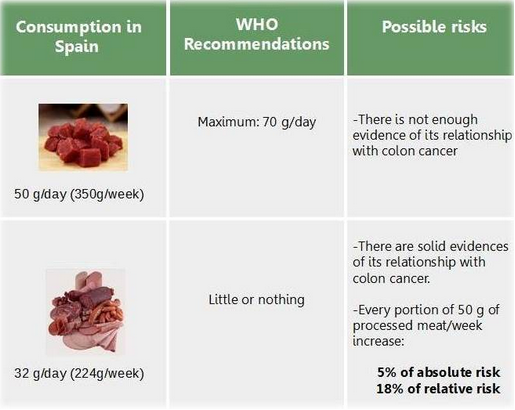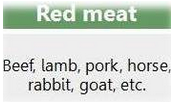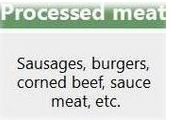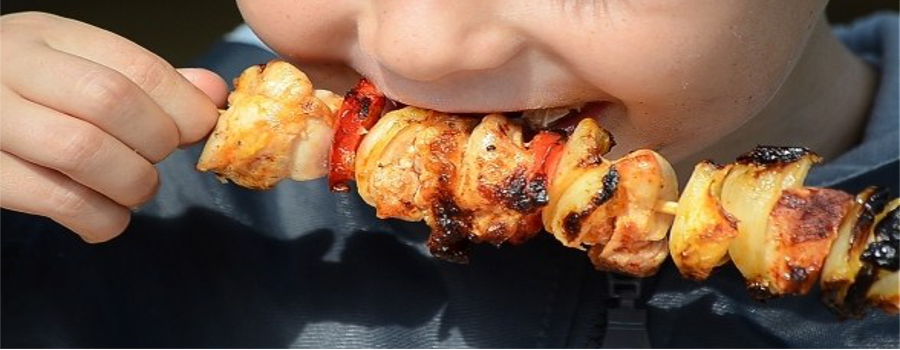The World Health Organization recommends reducing the red meat consumption and avoid processed meat intake, after the report of the International Agency for Research on Cancer (IARC).
For many years, it has been recommended to consume the red meat in moderation. So far, these suggestions were associated with risk of cardiovascular diseases, diabetes, obesity… However, for the first time, its massive intake has been related with the horrible cancer. This piece of news has spread panic in the society.
According to experts, potentially carcinogenic substances ingested with meat are heme iron (which brings its characterisitic red colour), nitrosamines (substances created when meat amines bind with nitrites and nitrates, used as preservatives), and certain chemicals substances, which are formed in the process of cooking.
What news for our country! Spain is mainly carnivore and the best hams of the world are produced here. According to the Report of Food Consumption in Spain, published in 2014 by the MAGRAMA, the Spanish consume every day about 50 grams of red meat and about 32 grams of processed meat.
Are we at risk?


At the beginning, red meat is not a problem in our country. On the one hand, the consumption does not exceed the amount recommended by WHO. On the other hand, there is not evidence between red meat and colon cancer. However, the situation changes with processed meat. In this case, according to WHO, there are solid evidences of its relationship with this kind of cancer. In addition, they warn that the risk increases with consumption and portions of 50 grams per week mean high risk.
In Spain, the processed meat consumption is almost five times higher than recommended amount. This could increase the danger to suffer a cancer. But it is necessary to know the significance of absolute and relative risk, in order to avoid mistakes. The best way to take in these concepts is with an example:

50 of 100 CARTIF researchers drink a coffee for breakfast. The other half choose a cocoa drink. Throughout the day, 5 of the researchers who have taken coffee and 2 of those have taken cacao feel dizzy. In terms of absolute risk, we would say that 10% of the first group and the 4% of the second have dizziness. So the absolute risk of feeling dizzy after coffee is 6% higher than after cocoa. In fact, the absolute risk is small.
On the other hand, the relative risk is also the difference between the percentages of both groups. Therefore, it is 2,5 times more likely to feel dizzy if we choose coffee rather than cocoa, or the risk of dizziness with coffee is 60% higher than with cocoa. Of course, using relative risk, percentages increase creating a bigger impact. Normally, media use it in their headlines in order to create more interest and excitement, and this is just what has happened wih the WHO information. The headlines have emphasized the relative risk (18%), in spite of the fact that the risk of developing cancer by eating red meat is only 5%.

However, stopping eating meat or eating raw meat are not the best solution. According to WHO, the raw meat can cause infections. Moreover, according to a study published in the journal BioMed in 2013, the relationship between meat consumption and mortality has chart ‘type j’, so it is worse not eat meat than eat a small amount. Meat is a fundamental source of nutrients, proteins, iron, zinc, vitamin B, vitamin A and essential fatty acids.
The meat sector is aware of the negative influence of this kind of information and how it could affect the sale of their products. In the CARTIF area of Agrofood, we are cooperating with manufacturers of pork sausage to improve the nutritional profile of these products. Getting healthier meat products without its losing organoleptics properties is one of our challenge in CARTIF.
- Waiter! One of dung beetles! - 10 February 2023
- Attention: NutriScore Traffic Light! We have a huge mess - 14 January 2021
- Acrylamide has a special ‘COLOR’ - 23 January 2019
